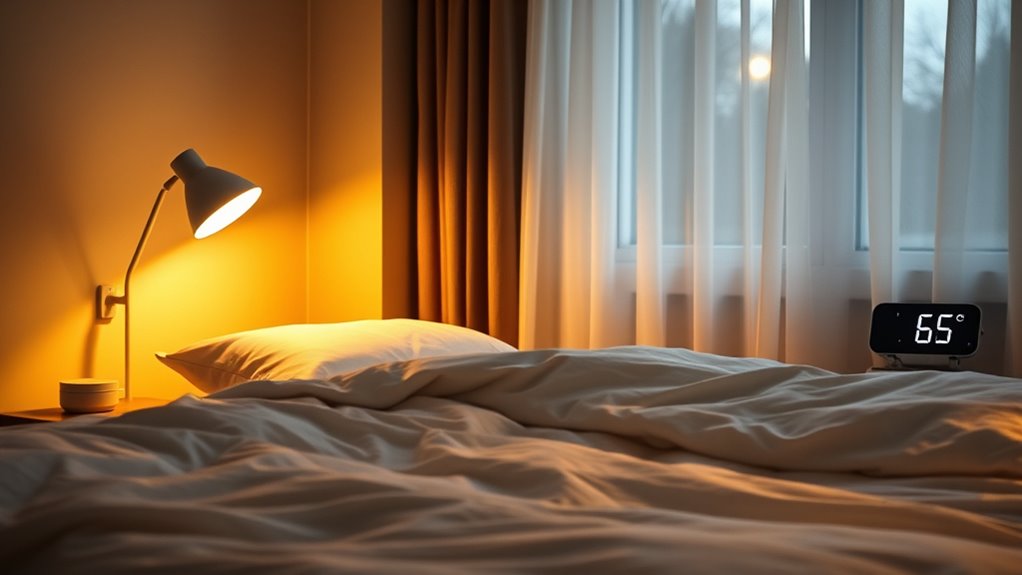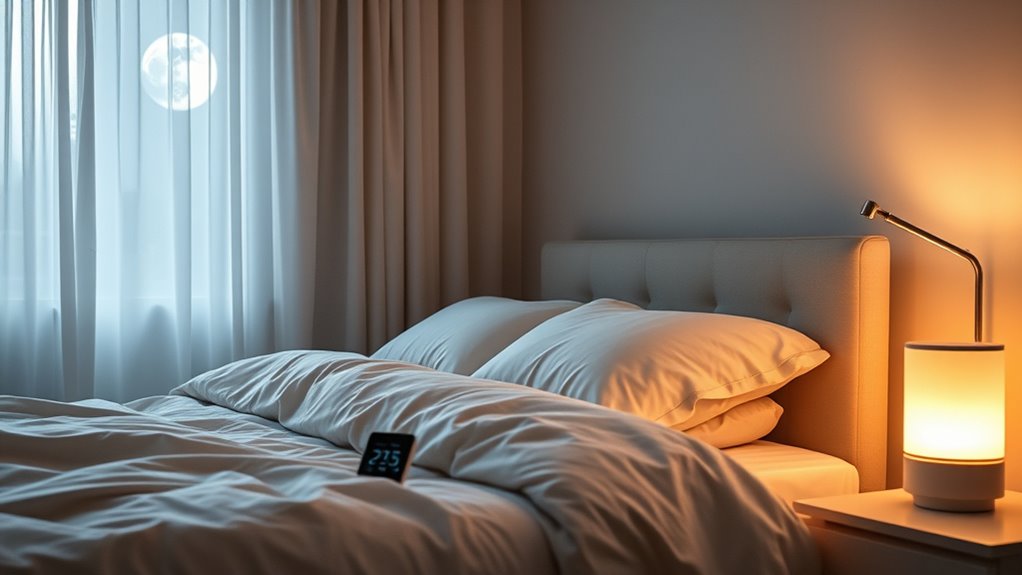To improve your sleep hygiene, keep your bedroom’s temperature between 60-67°F to help your body relax. Block out unwanted light with blackout curtains or an eye mask, and limit screen use at least an hour before bed to boost melatonin production. Use white noise machines or earplugs to minimize disruptive sounds. Following these tips can create a calming environment that promotes better sleep—stick around to discover more ways to optimize your rest.
Key Takeaways
- Maintain bedroom temperature between 60-67°F to promote comfortable, uninterrupted sleep.
- Minimize light exposure before bed using blackout curtains or eye masks to support melatonin production.
- Reduce noise with white noise machines or earplugs to prevent sleep disruptions.
- Establish consistent sleep and wake times to reinforce your body’s internal clock.
- Develop calming pre-sleep routines, avoiding caffeine and screens, to signal readiness for rest.

Good sleep is essential for your overall health and well-being, but many people struggle to get enough restful rest each night. One of the most effective ways to improve your sleep quality is by paying attention to your sleep environment and establishing consistent sleep routines. These two elements play a pivotal role in signaling your body that it’s time to wind down and prepare for rest.
Your sleep environment should be cool, dark, and quiet. Temperature impacts your ability to fall asleep and stay asleep throughout the night. A bedroom that’s too warm can cause discomfort and restless tossing, while a room that’s too cold can make it hard to relax. Ideally, keep your bedroom temperature between 60 and 67 degrees Fahrenheit. Light is another critical factor; exposure to bright or blue light before bed can interfere with melatonin production, the hormone that regulates sleep. Use blackout curtains or an eye mask to block out external light, and consider turning off screens at least an hour before bed. If you need to use devices, activate night mode or blue light filters to minimize disruption.
Keep your bedroom cool, dark, and quiet for better sleep.
Sound levels also influence sleep quality. While some people can sleep through background noise, most find that loud or sudden sounds wake them up or disrupt their sleep cycles. Using earplugs or a white noise machine can create a calming environment that masks disruptive sounds. Consistency in your sleep routines helps reinforce your body’s internal clock. Going to bed and waking up at the same time each day—even on weekends—trains your body to anticipate sleep and wakefulness, making it easier to fall asleep naturally. Establishing a calming pre-sleep routine, such as reading, gentle stretches, or listening to soothing music, signals to your brain that it’s time to wind down.
Furthermore, your sleep routines should include avoiding caffeine, heavy meals, and alcohol close to bedtime, as these can interfere with your ability to fall asleep or cause fragmented sleep. Creating a consistent routine and sticking to it helps your body recognize the cues for sleep, making it easier to drift off faster and enjoy more restorative rest. Additionally, understanding the history of pinball machines reveals how recreational activities can serve as social and cultural outlets, which may influence leisure routines and sleep patterns for enthusiasts. Creating a consistent routine and sticking to it helps your body recognize the cues for sleep, making it easier to drift off faster and enjoy more restorative rest. Remember, your sleep environment and routines are interconnected; optimizing both helps your body transition smoothly into sleep and stay there longer. By paying attention to temperature, light, sound, and establishing consistent habits, you set yourself up for better sleep, waking up refreshed and ready to face the day.
Frequently Asked Questions
How Does Room Temperature Affect REM Sleep Quality?
You might notice that room temperature regulation greatly impacts your REM sleep patterns. When your room is too hot or cold, it can disrupt your body’s ability to enter and sustain REM sleep stages. Ideally, keeping your bedroom around 60-67°F helps promote ideal REM sleep quality. By maintaining a comfortable temperature, you support better sleep cycles, allowing your brain and body to fully rest and recover each night.
What Types of Lighting Are Best for Sleep Environments?
You should opt for dim, warm lighting in your sleep environment. A night light with soft, amber or red hue helps prevent disruption without disturbing your sleep cycle. Using blackout curtains blocks out external light, creating a dark room that promotes melatonin production. Keep lighting minimal and avoid bright or blue light before bed to improve sleep quality and help you fall asleep faster.
Can White Noise Improve Sleep for Light Sleepers?
Yes, white noise benefits light sleepers by creating a consistent sound environment that masks sudden noises. This helps you stay asleep longer and reduces disruptions during the night. Incorporating white noise into your sleep environment can make it easier to fall asleep and improve overall sleep quality. You might find that using a white noise machine or app helps you maintain a peaceful, uninterrupted sleep, especially if you’re sensitive to light or sound disturbances.
How Do Sound Levels Impact Sleep Cycles?
Sound levels are like a rollercoaster for your sleep cycles, causing abrupt shifts. Too much noise pollution can disrupt your REM and deep sleep stages, while sound masking helps create a steady environment. Lower sound levels promote uninterrupted sleep, but loud noises can wake you or fragment your rest. You should aim for a peaceful background noise to support healthy sleep cycles and reduce the impact of external disturbances.
Are There Specific Temperature Ranges Recommended for Different Ages?
You should aim for a temperature between 65-70°F (18-21°C) for ideal sleep, adjusting based on age. Infants and elderly may need slightly warmer or cooler settings to support thermoregulation strategies. To improve your sleep environment, consider making sleep environment adjustments like using fans or heaters, and guarantee the room stays consistent in temperature. This helps your body maintain proper thermoregulation, promoting better sleep quality across different age groups.
Conclusion
By paying attention to your sleep environment—keeping your room cool, dark, and quiet—you’ll transform your nights from a battle into a blissful escape. Don’t underestimate the power of these simple tweaks; they can turn your sleep quality from a mere flicker into a blazing inferno of restful rejuvenation. Stick to these tips, and you’ll wake up feeling more refreshed than you’ve ever felt before. Sleep well, and let your nights be legendary!









